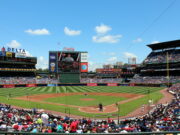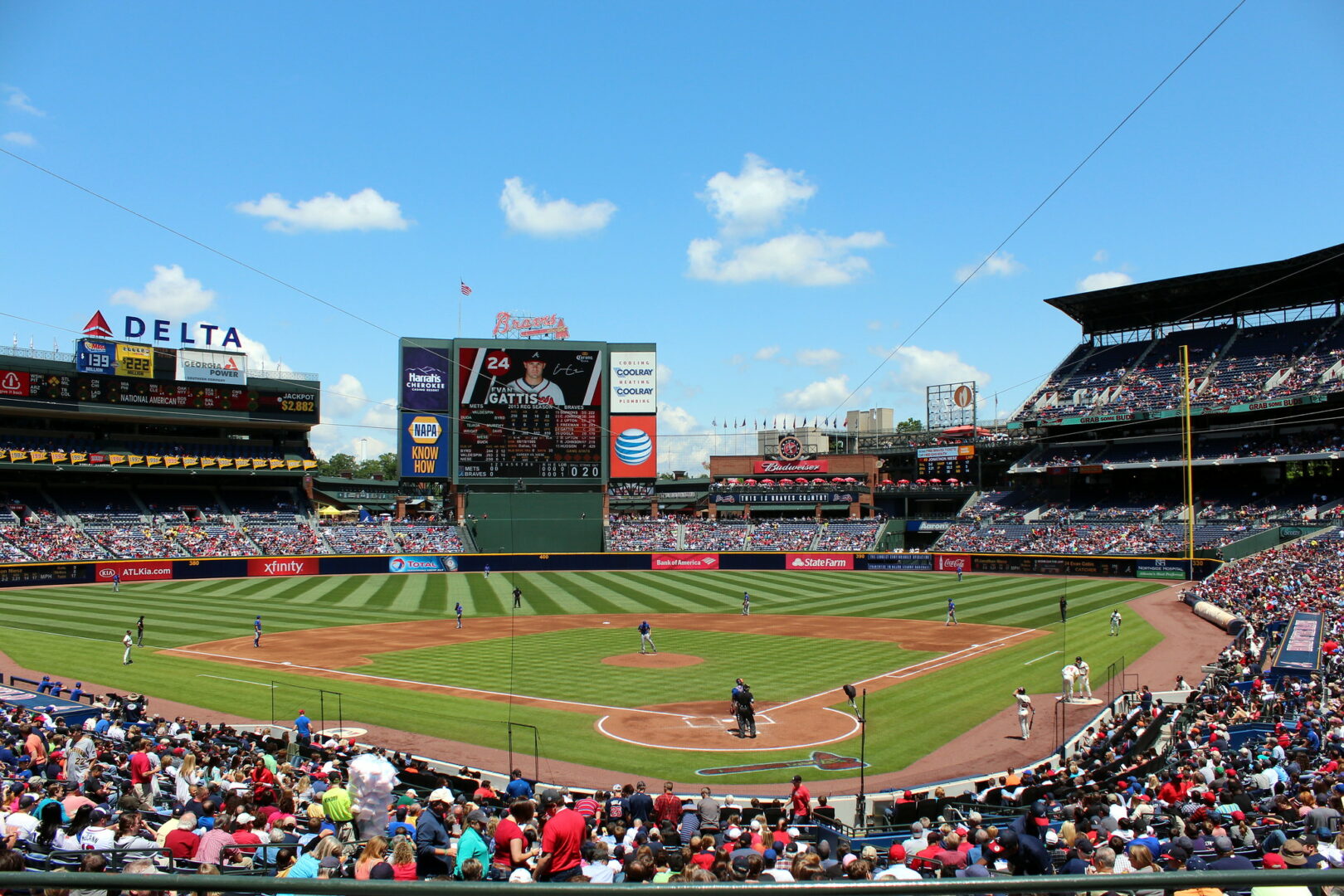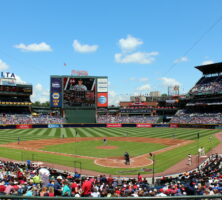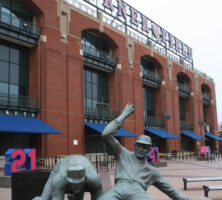Turner Field was the home stadium of the Atlanta Braves baseball team from 1997 to 2016 and was named for former Braves owner Ted Turner. Originally known as Centennial Olympic Stadium, the venue was constructed for track-and-field events for the 1996 Olympic Games and was subsequently remodeled by architect George T. Heery to become a baseball park in time for the 1997 major league season.
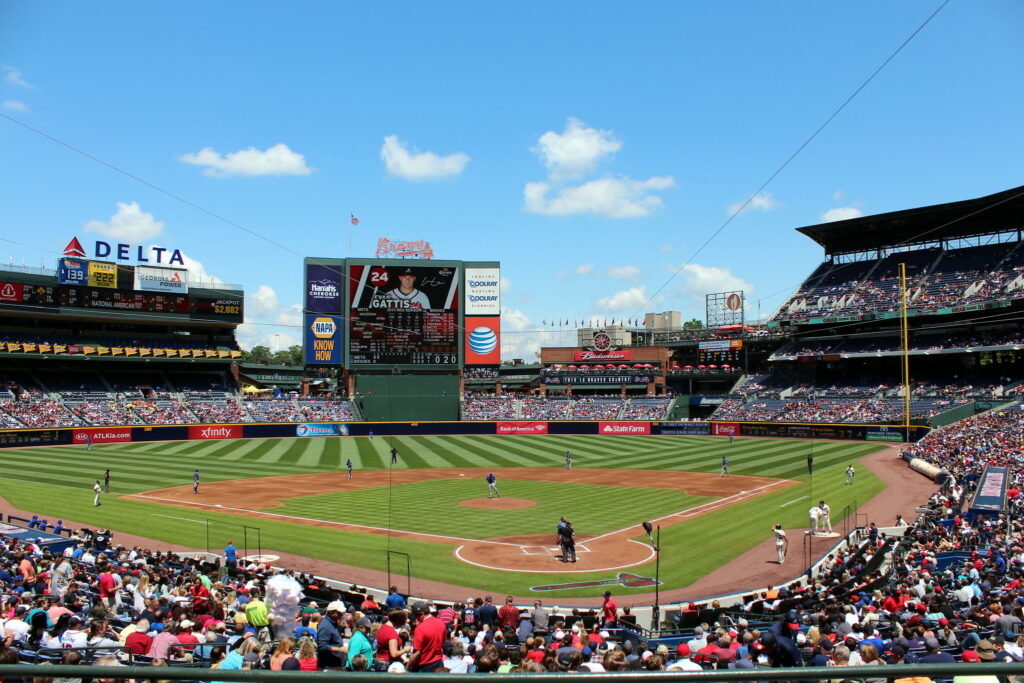
Image from Wally Gobetz
Situated south of downtown Atlanta, Turner Field replaced Atlanta
Atlanta–Fulton County Stadium opened in 1966 and hosted its final game on October 24, 1996, when the New York Yankees defeated the Braves one to zero in game five of the World Series. The old stadium site served as a parking lot for Turner Field, which was located across the street at 755 Hank Aaron Drive. The address honors Braves player Hank Aaron, who broke Babe Ruth’s home-run record in 1974 at Atlanta–Fulton County Stadium and ended his career with a total of 755 home runs in 1976.
When Atlanta won its bid to host the 1996 Olympics, the Atlanta Committee for the Olympic Games (ACOG) began planning for the construction of several venues, including a track-and-field stadium. The Braves organization, ready to be rid of the obsolete Atlanta–Fulton County Stadium, arranged with ACOG to become the tenants of Centennial Olympic Stadium when the summer games ended. The original cost of the stadium was $207 million, which was financed by ACOG.
At the conclusion of the Olympics, nearly half of the venue’s temporary bleachers were removed as the stadium was turned into an open-air baseball park, not unlike the popular Oriole Park at Camden Yards in Baltimore, Maryland, which had received many positive reviews since its opening in 1992. A number of cities with major league teams, including Atlanta, constructed similar old-style facilities: Arlington, Texas (Ameriquest Field, 1994); Cincinnati, Ohio (Great American Ballpark, 2003); Cleveland, Ohio (Jacobs Field, 1994); Detroit, Michigan (Comerica Park, 2000); Milwaukee, Wisconsin (Miller Park, 2001); and Pittsburgh, Pennsylvania (PNC Park, 2001).

Image from David
Turner Field was owned by the city of Atlanta and Fulton County. The Braves had a forty-year lease—$1 million per year until 2016, and $1.5 million thereafter—to use the stadium. Turner Field hosted its first baseball game on April 4, 1997, when the Braves defeated the Chicago Cubs five to four. On October 23, 1999, the stadium hosted game one of the World Series, in which a crowd of 51,342 saw the New York Yankees defeat the Braves four to one. Game two was played the next day before an audience of 51,226, and the Yankees won again, seven to two, en route to a four-game sweep of the series.
In Turner Field’s first seven years of operation (1997-2003), average attendance for Braves games was 37,449 per game and 3 million per season. With regard to attendance, the team’s first year was its best, with average attendance at 42,771 per game and 3.46 million for the season. After a several-year decline, average attendance at Turner Field increased each year from 2005 to 2007, when the average attendance was 33,891 per game, and 2.75 million for the season. Average attendance again declined between 2007 and 2015, bottoming out at 2 million in the 2015 season.
Turner Field’s largest baseball gathering took place on July 21, 2007, when the Braves defeated the St. Louis Cardinals fourteen to six before 53,953 fans. Other record-setting attendance days include July 4, 2005 (52,274 fans; Braves beat the Chicago Cubs, four to zero); July 3, 2004 (51,831 fans; Braves lost to the Boston Red Sox, six to one); September 24, 2005 (51,775 fans; Braves beat the Florida Marlins, six to one); April 1, 2002 (51,638 fans; Braves beat the Philadelphia Phillies, seven to two); and July 31, 2004 (51,125 fans; Braves beat the New York Mets, eight to zero).
The Turner Field facility included more than a dozen attractions, including Coca-Cola Sky Field, the Braves Fun Zone, the interactive Scouts Alley, Turner Beach, Monument Grove (where the retired numbers of former Braves players were displayed), the Ivan Allen Jr. Braves Museum and Hall of Fame (named for former Atlanta mayor Ivan Allen Jr.), Tooner Field, and the “My South Cooks” Suite. It also hosted many non-baseball events each year, including music concerts, weddings, receptions, holiday parties, product launches, and student proms. The stadium’s parking lot hosted vehicle ride-and-drive events, road races, and a circus.
In 2013 the Braves announced that they would move out of downtown Atlanta and into Cobb County. The Braves’ new stadium, SunTrust Park (later Truist Park), opened in April 2017. In 2015 a group of developers and Georgia State University won a bid to turn the sixty-seven-acre site into a southern expansion of Georgia State’s campus and a privately held commercial and residential hub. Under the new plan, Turner Field was converted into a Georgia State football stadium in 2017 and was renamed Center Parc Stadium in 2020.


